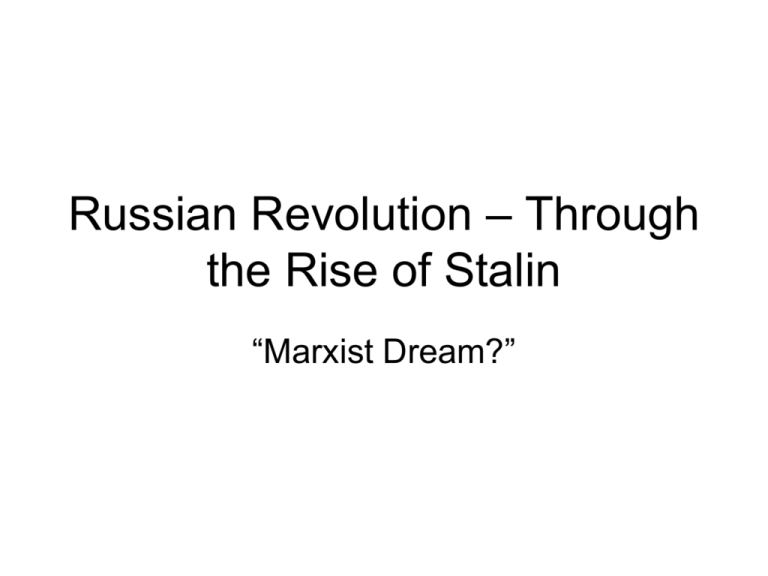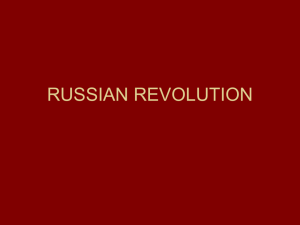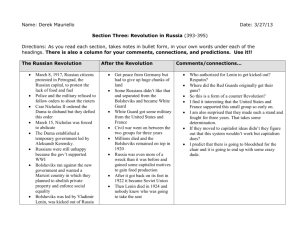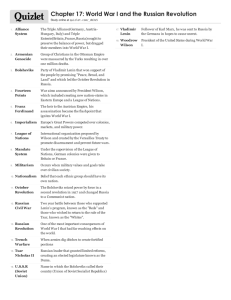Russian Revolution – Through the Rise of Stalin
advertisement

Russian Revolution – Through the Rise of Stalin “Marxist Dream?” I. Background – Marxism • A. Communist Manifesto (1848) by Marx (1818 – 1883) and Friedrich Engels (1820-1895) • 1. Dialectal materialism – communism is the final form of government resulting from a historical progression. It is capitalism’s successor. Economic history – Barter, Slavery, Capitalism then Communism • 2. Surplus value theory – the proletariat (workers) can no longer use the products of manufacture because the bourgeois capitalists lower wages. Therefore, a revolution is inevitable and a socialist government will be formed. • 3. Equality of classes will result from the abolishment of private property. II. Other Background – major groups in Russian Empirein early 1900s • • • • • • • • • A. Czar Alexander III, from 1881-1894, instituted policies of autocracy (has all the political power) and Russification (persecution of all non-Russians – limit their nationalism). Then Czar Nicholas II 1894-1917. B. Political parties: Politically active but no representation until 1905 1. Constitutional Democrats (Cadets) – Reflected the middle class by not worrying about the proletariat. Capitalists 2. Social Revolutionaries (Narodniks) – Believed that the formation of capitalism was not necessary for socialism to take hold (from agrarian system directly to socialism). 3. Social Democrats (Marxists) – Adherents to Marxism. In 1903, the party split: - Bolsheviks – small group of elite revolutionaries, ed by V.I. Lenin, the “strong authority at the top.” No toleration of varying opinions or cooperation with outside influences, unless strategically used. - Mensheviks – mild revolutionaries who favored a more democratic style (everyone has input). C. The Russians suffered a humiliating defeat in the Russo – Japanese War (1904) 1. Treaty of Portsmouth – Russia loses all land and rights in Manchuria, as well as military strength. This allows the underground political parties to surface and the Revolution of 1905 to begin. III. Revolution of 1905 • • • A. Bloody Sunday (January 1905) – Father Gapon, a Russian Orthodox priest, led 200,000 Russians on a peaceful march to the czar’s Winter Palace. The czar’s troops fired on the demonstrators, killing hundreds. 1. Soviets, or worker’s councils, formed and demanded reform. 2. Peasant uprisings (burning of manor houses and overrunning of lands) B. October Manifesto – issued by Czar Nicholas II in response to a massive strike by the Petrograd (St. Petersburg) Soviet. It promised the: 1. Development of a constitution. 2. Establishment of a Duma (legislature/Parliament) to represent all classes. 3. Freedom of speech, assembly, association and conscience. C. Peter Stolypin, the czar’s principal minister, initiated reforms: 1. Peasants can leave their land communes (mirs) and take land that is rightfully theirs. 2. Abolishment of peasant debts led to a wealthy peasant class (Kulaks). 3. Increase in the power of zemstzos (provincial councils). • By 1907 these reforms are ignored!!! Return to the old system • • • • • • • • IV. Revolution of 1917 – March 5 Causes Cause 1 - WWI • A. World War I – Russia is again devastated by loss of manpower and ammunition. • 1. Over 2,000,000 soldiers are lost, and 4,000,000 wounded due to the advance of the Central Powers, as well as incompetent leadership from Russian aristocrats. • People want the war to end!!! Cause 2 – Rasputin and Russian morality • B. Rasputin – “Mad monk” who apparently healed the czarevitch (heir) of hemophilia. • 1. He had a say in appointments of officials to high office. • 2. Anyone wishing to speak to the czar must first go through Rasputin. • 3. As a result, members of all classes resented the royal family and government. Cause 3 – Other less major complaints • C. Other dissatisfaction: • 1. Anti-German sentiment is high (the czarina is German). • 2. Czar Nicholas is thought to be incompetent and arrogant. • 3. More food shortages in industrial towns. Cause 4 – Food shortages lead to violence and new “local” powers • D. Fighting breaks out in St. Petersburg. • 1. Peasant food riots. • 2. Soldiers turned traitors and support the peasants. Some of them free political prisoners. • 3. Armed workers stormed factories. • 4. Soviets formed. • 5. Two authorities emerged: • - Petrograd Soviet – representing revolutionary forces, 58% Menshevik, supported by soldiers and workers. It wanted to end Russia’s involvement in WWI. • - Duma committee (Provisional Government and then later the Constituent Assembly) – representing moderates and constitutionalists Cause 5 – Czar abdicates and Provisional Government set up • . • E. Provisional Government – set up by Duma because of pressure from the soviets. • 1. Prince Lvov (non-party moderate) is appointed President. • 2. To appease socialists, Alexander Kerensky, a Narodnik, is appointed Minister of Justice. • 3. It wanted to expand Russia’s territory. • 4. Institution of local self-government by a police force. • 5. Abolition of class, religious and nationality restrictions. • 6. Czar Nicholas II abdicates the throne. • 7. Russia is now a republic. V. Revolution of 1917 – November (Bolshevik Revolution) • A. Causes: Provisional Government very unpopular!!! Does not have support of the lower classes because: • 1. The promised redistribution of land never took place. • 2. Discipline collapsed in the army because of Order Number 1, stating that command will be given to committees. Both officers and soldiers refused to • 2. Tried to continue war w/ Germany • 3. Promised peasants redistribution of land, but took no actions. • 4. Was opposed by Petrograd Soviet that wanted a speedy end of the war. • 5. Lost the discipline of the people by issuing Order No. 1 B. Lenin and the Bolsheviks • 1. Arrive in Petrograd (St. Petersburg). – Mid April, took sides w/ Petrograd Soviet • 2. After abortive coup in July, they flee to Finland. • 3. Prince Lvov gave his power to Kerensky • 4. Kerensky’s government did not succeed because he wanted to stay in war w/ centralized powers and didn’t help w/ storages of food. • 5. General Kornikov dispatched a force of cavalry to restore order by suppressing the soviets. Didn’t work. C. Lenin’s points – won over soldiers, peasants, and workers by promising them “Peace, Land, and Bread.” • • • • The points called for: 1. Immediate peace w/ central powers. 2. Redistribution of land to peasants 3. Transfer of industrial plants from capitalists to committees of workers • 4. Recognition of soviets as the supreme power D. The Bolsheviks take over in St. Petersburg and overthrow Provisional Government • 1. Nov. 6 & 7, 1917 – Bolsheviks take over telephone exchanges, railway stations, and electric power plants of Petrograd • 2. They storm the Winter Palace where Kerensky’s government sat and seized other key centers of Petrograd • 3. Instead of Provisional Government, Council of People’s Commissars was formed. • a. Lenin was the head of it, Trosky was commissar for foreign affairs, and Stalin was commissar for nationalities • 4. Caused Kerensky to fled to US • 5. Congress of Soviets – tried to set up “just democratic peace” and “abolished all landowning property” • 6. Constituent Assembly broken up • 7. March 1918 – renamed themselves Communists VII. The New Regime: The Civil War, 1918 – 1922 • a. Russia (Soviet Union – under Lenin’s leadership) and Germany signed the peace of Brest-Litovsk that surrendered to Germany control of the Baltic provinces, Poland and Ukraine. A. Civil War lasted until 1922 – Communists win with unity and terror tactics • 1. Tsarist reactionaries, liberals, bourgeois, zemstvos members, Constitutional Democrats, anti-Leninist socialists, Mensheviks, and Social Revolutionaries Vs. Bolsheviks and Communists (all fighting each other) • 2. First institution found Dec.7,1917- secret political police commonly known as Cheka, also goes under the names OGPU, NKVD, MVD, KGB. • 3. Jan 1918 – Red Army is founded w/ Leon Trotsky as war commissar and founder (Bolsheviks are unified and willing to die for their beliefs unlike other groups) • 4. Government required peasant to make states deliveries and invited labor unions to send armed men into the country to procure food by force. (Communists gain wealth and power) • 5. Class Wars broke out between the farmers and the city workers B. Foreign Interventions – why foreign powers only get involved on a limited basis • 1. Spring of 1918 – Georgia, Armenia, and Azerbaijan in the Caucasus proclaimed their independence • 2. Omsk – a disaffected group, proclaimed independence of Siberia. • 3. Red army fought in Ukraine first against Germans, then the French who occupied Odessa as soon as the war ended in Europe. • - It also re-conquered Georgia, Armenia, and Azerbaijan, the ones that proclaimed their independence • 4. French aided the Poles and Ukrainians while Britain and U.S. wanted nothing to do with wars after the armistice of World War I was signed • 5. National peace was finally reached. C. Red Terror (Bolshevik Terror) was carried out by Cheka – SUCCEEDED • 1. Broke out during the civil war, it was a response to civil and foreign war • 2. In Russia, thousands were shot. • 3. The terror was aimed at the physical extermination of all who opposed the new regime • a. Strengthen and enrich the country • b. Make it military and industrially self-sufficient • c. lay the groundwork for a true workers’ society • d. overcome the Russian reputation for backwardness First Five – Year Plan – installed by Stalin • declared successful in 1932, it was administered by an agency called Gosplan. Gosplan determined the number of people to go into each profession, and the number of quantities of different materials that should be produced. Second Five – Year Plan • launched and lasted until 1937 The Collectivization of Agriculture • 1. The plan set up collective farms- averaging a few thousand acres apiece • 2. Individual peasants were to pool their privately owned fields and livestock in these collectives • a. Kulaks (prosperous peasants) who possessed fields and stock in considerable amount resisted surrendering them to the new collectives. Kulaks were liquidated as a class. • b. Big farmers slaughtered their animals (horses, cattle, pigs, and poultry) rather than give them up worst unforeseen calamity of the first Five – Year Plan • 1. Sparked a deadly famine in southeast Russia in 1932 (cost millions of lives) The Growth of Industry • • • • • • • • • • • • • • 1. Great Britain industrialization had been gradual; in Germany and the United States it had been more rapid; but in the USSR (1928-1938) production of steel and iron had expanded four times and that of coal three and a half times. 2. Copper mines were open in the Urals and around Lake Balkhash, lead mines in eastern Asia and in the Altai Mountains 3. Grain producing regions were developed in Siberia 4. The Kuznetsk Basin was found to possess coal deposits 5. For the first time, inner Asia was turning industrial 6. The USSR industry lagged behind the West D. Social Costs and Social Effects of the Plans 1. Kulaks lost their lives and others were sent off to correctional labor camps. 2. Those being forced to enter a program of self-denial (peasants were all collectivized) were going without the better food and housing, all for the industry of the country 3. People were told to look forward to better clothing, better housing, more leisure, etc… Morale was preached by propaganda 4. Hard work and low wages 5. No one could leave the country without special permission 6. No free labor unions, no free press, no freedom of association, low religious tolerance 7. Socialism caused: a) No cycle of boom and depression b) Less misuse of women and children c) No complete equality of income – government officials, managers, engineers, and favored artists and intellectuals received the highest rewards. d) Competition persisted The Purge Trials of the 1930’s • 1. Stalin was paranoid and though that there were plots in the party and government to unseat him. • 2. He executed those who were original Bolsheviks, instrumental in carrying out the revolution, as well as high military officers. (They were tried on trumped-up charges) • 3. Stalin became on of the most powerful dictators by gaining more power and strength over the party, the government, and the nation. The international Impact of Communism • A. Lenin, after the Bolshevik Revolution, saw Russia merely as a center for actions to be made in an international class war. • 1. In Germany, followers of Lenin organized the Spartacist Movement and attempted to overthrow their moderate socialist government. • 2. In Hungary, Nela Kun set up a soviet regime for several months. • 3. Lenin and the Bolsheviks lent all possible aid to these attempts. B. Third International (communist International or Comintern) • 1. Formed when radicals of the Second International joined with the Russian Communist Party. • 2. Its purpose, according to Lenin: “To begin to carry into effect the dictatorship of the proletariat.” It was also set up to discredit and isolate the moderate socialists, whom the Bolsheviks despised the most. • 3. Its Executive committee was filled with members of the Russian Central Committee. Therefore, Russia dominated the Third International. • 4. It was a weapon for revolution, not a welfare system. • 5. In 1927, under Stalin’s policy of building socialism in one country, the Third International moderated its activities. In 1943, Russia terminated it as an act of good will to both Britain and the U.S. C. Other impacts: • 1. Europe now feared an existing Marxist society, covering 1/6th of the Earth • 2. Socialists, previously seen as dangerous, now considered respectable • 3. People “planned” against the uncertainty of capitalism • 4. The 3rd World (poor) Countries, under European colonization, showed admiration toward Russia because it modernized without foreign intervention







